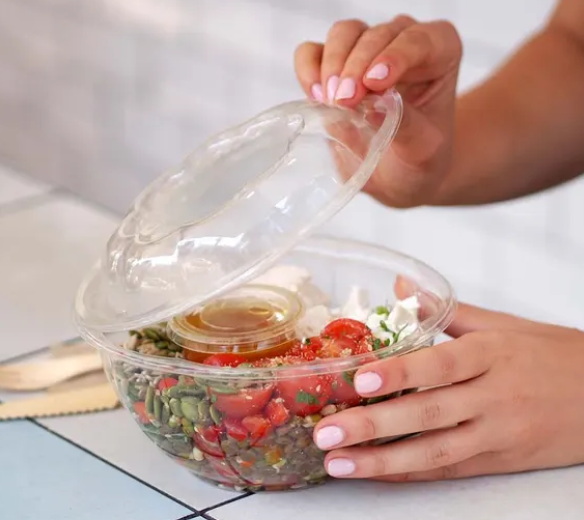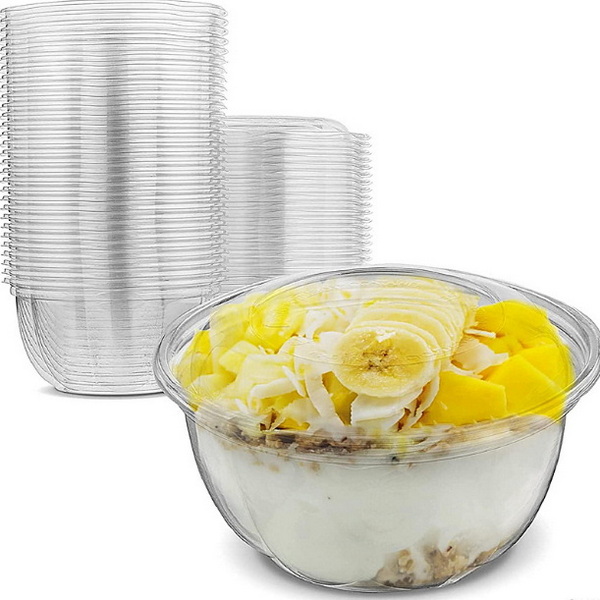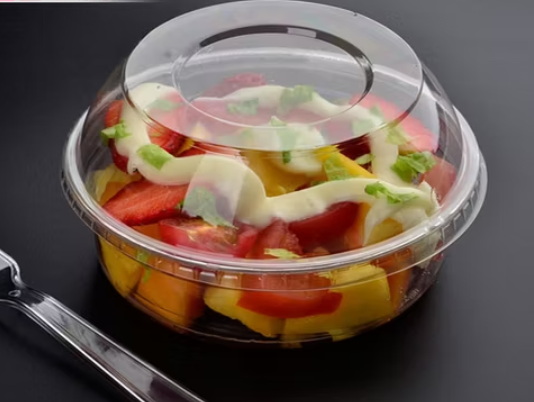
Content Menu
● Introduction to Disposable Pho Bowls
>> Materials Used for Disposable Pho Bowls
● Durability and Heat Resistance
>> Leak-Proof Performance
● Environmental Impact
● Choosing the Right Disposable Pho Bowl
>> Tips for Sustainable Practices
● Market Trends and Consumer Preferences
>> Impact on Business Operations
>> Customization and Branding Opportunities
>> Regulatory Compliance
● Comparison of Materials
● Future Developments
● Conclusion
● FAQ
>> 1. What Materials Are Used for Disposable Pho Bowls?
>> 2. Are All Disposable Pho Bowls Compostable?
>> 3. Can Disposable Pho Bowls Be Used in Microwaves?
>> 4. How Do I Choose the Best Disposable Pho Bowl for My Business?
>> 5. Are Aluminum Foil Bowls Suitable for Serving Hot Pho?
In the fast-paced world of food service, disposable pho bowls have become an essential item for serving hot, delicious meals like pho. These bowls must not only be durable enough to hold scalding liquids without leaking or warping but also meet the growing demand for sustainable packaging. This article delves into the durability and eco-friendliness of various disposable pho bowl materials, exploring their heat resistance, leak-proof performance, and environmental impact.

Introduction to Disposable Pho Bowls
Disposable pho bowls are designed to be convenient, easy to use, and environmentally responsible. They come in various materials, each with its strengths and weaknesses. Whether you're running a trendy café, a catering business, or a takeout service, choosing the right disposable pho bowl is crucial for both customer satisfaction and brand reputation.
Materials Used for Disposable Pho Bowls
1. Biodegradable Sugarcane (Bagasse) Bowls
Bagasse bowls are made from sugarcane fibers, a by-product of sugar production. These bowls are highly durable, can withstand boiling temperatures, and are fully compostable, making them an excellent eco-friendly choice for serving hot pho. The manufacturing process involves mixing sugarcane fibers with water and sometimes a natural binder, then pressing them into molds under high heat and pressure. This results in a sturdy, paper-like texture that maintains its shape even when filled with hot liquids.
Bagasse bowls are not only durable but also microwave and freezer safe, providing versatility for both food service establishments and consumers. They can be customized with logos or designs, making them ideal for businesses looking to enhance their brand image while promoting sustainability.
2. Cornstarch Bio-Plastic (PLA/CPLA) Bowls
PLA/CPLA bowls are derived from fermented plant sugars, often cornstarch. CPLA, a crystallized form of PLA, offers enhanced heat resistance, making it suitable for hot pho. However, these bowls require industrial composting to fully break down and are not intended for prolonged microwave use.
CPLA bowls feature a seamless construction that ensures leak-proof performance, even when filled with hot, liquid food.
3. Aluminum Foil Bowls
Aluminum foil bowls are made from thin sheets of aluminum and are highly durable and leak-proof. They offer excellent heat conduction, making them ideal for reheating applications, but they can become very hot to handle.
Aluminum bowls are infinitely recyclable, providing a sustainable option if properly recycled.
4. Kraft Paper Bowls with PLA Lining
These bowls combine the eco-friendliness of kraft paper with the leak-proof performance of PLA linings. However, they are not fully compostable unless disposed of in specialized facilities.
5. Polypropylene (PP) Plastic Bowls
PP plastic bowls are robust, lightweight, and suitable for boiling temperatures. They are often microwave-safe and can be reused several times, but their environmental impact is significant if not properly recycled.
6. Foam Bowls
Foam bowls are made from expanded polystyrene (EPS) and offer excellent insulation, keeping soup hot while the exterior remains cool. However, they are not biodegradable and contribute significantly to landfill waste.
Durability and Heat Resistance
The durability of disposable pho bowls largely depends on their material and construction. For instance:
- Bagasse bowls are robust and can withstand boiling temperatures, making them ideal for serving hot pho. They also provide a level of insulation, helping maintain the soup's temperature.
- CPLA bowls can handle temperatures up to 100°C (212°F), suitable for hot soup but not for prolonged microwave use.
- Aluminum foil bowls offer excellent heat conduction but require caution when handling due to their high thermal conductivity.
Leak-Proof Performance
Leak-proof performance is crucial for disposable pho bowls. Materials like bagasse and CPLA provide a tight fiber network or seamless construction that prevents leaks, even with oily or acidic soups.

Environmental Impact
The environmental impact of disposable pho bowls varies significantly depending on the material:
- Bagasse bowls are fully compostable and biodegradable, reducing waste and supporting sustainable practices. They require less energy to produce compared to conventional plastics.
- CPLA bowls require industrial composting to break down, limiting their environmental benefits unless properly disposed of.
- Aluminum foil bowls are recyclable, offering a sustainable option if recycled correctly.
Choosing the Right Disposable Pho Bowl
When selecting disposable pho bowls, consider the following factors:
1. Material: Ensure the material is food-grade certified and suitable for hot foods.
2. Heat Resistance: Choose bowls that can withstand the temperature of your pho.
3. Leak-Proof Performance: Opt for materials with a tight fiber network or seamless construction.
4. Environmental Impact: Consider the bowl's end-of-life disposal and its environmental footprint.
Tips for Sustainable Practices
- Use Compostable Bowls: Opt for fully compostable materials like bagasse to reduce waste.
- Recycle Properly: Ensure aluminum and PP bowls are recycled through appropriate channels.
- Avoid Foam: Limit the use of foam bowls due to their environmental drawbacks.
Market Trends and Consumer Preferences
The market for disposable pho bowls is shifting towards more sustainable options. Consumers are increasingly aware of the environmental impact of their choices, driving demand for eco-friendly materials like bagasse and CPLA. Businesses are responding by offering customizable, biodegradable bowls that enhance brand image while supporting sustainability.
Impact on Business Operations
- Cost Considerations: While eco-friendly options may be more expensive upfront, they offer long-term benefits by aligning with consumer values and reducing waste management costs.
- Brand Image: Companies that adopt sustainable packaging solutions can enhance their brand reputation and appeal to environmentally conscious consumers.
- Operational Efficiency: Choosing the right material can streamline operations by reducing spillage risks and improving customer satisfaction.
Customization and Branding Opportunities
Customizing disposable pho bowls with logos or designs can be an effective marketing strategy. It not only enhances brand visibility but also communicates a commitment to sustainability, which can be a key differentiator in a competitive market.
Regulatory Compliance
Businesses must ensure that their disposable pho bowls comply with local regulations regarding food safety and environmental standards. This includes ensuring that materials are food-grade certified and properly labeled for disposal.
Comparison of Materials
| Material | Heat Resistance | Environmental Impact | Cost |
| Bagasse | High | Compostable | Moderate |
| CPLA | Medium | Industrial Composting | Moderate |
| Aluminum Foil | High | Recyclable | Low |
| Kraft Paper PLA | Medium | Partially Compostable | Moderate |
| PP Plastic | High | Recyclable | Low |
| Foam | High | Non-Biodegradable | Low |
This comparison highlights the trade-offs between different materials, helping businesses make informed decisions based on their priorities.
Future Developments
As technology advances, new materials and manufacturing processes are being developed to improve the sustainability and performance of disposable pho bowls. Innovations such as plant-based bioplastics and advanced composting technologies are expected to further reduce the environmental footprint of disposable packaging.
Conclusion
Disposable pho bowls must balance durability, heat resistance, and environmental responsibility. By understanding the strengths and weaknesses of different materials, businesses can make informed decisions that enhance customer satisfaction while supporting sustainable practices.

FAQ
1. What Materials Are Used for Disposable Pho Bowls?
Disposable pho bowls are made from a variety of materials, including biodegradable sugarcane (bagasse), cornstarch bio-plastic (PLA/CPLA), aluminum foil, kraft paper with PLA linings, polypropylene (PP) plastic, and foam. Each material offers unique benefits in terms of heat resistance, leak-proof performance, and environmental impact.
2. Are All Disposable Pho Bowls Compostable?
Not all disposable pho bowls are compostable. While bagasse bowls are fully compostable, PLA/CPLA bowls require industrial composting, and kraft paper bowls with PLA linings are not fully compostable unless disposed of in specialized facilities.
3. Can Disposable Pho Bowls Be Used in Microwaves?
Some disposable pho bowls, like those made from natural fibers such as bagasse, can be used in microwaves. However, PLA/CPLA bowls are not intended for prolonged microwave use due to their potential to warp or release chemicals.
4. How Do I Choose the Best Disposable Pho Bowl for My Business?
When choosing disposable pho bowls for your business, consider factors such as heat resistance, leak-proof performance, and environmental impact. Ensure the material is food-grade certified and suitable for hot foods, and consider the bowl's end-of-life disposal.
5. Are Aluminum Foil Bowls Suitable for Serving Hot Pho?
Yes, aluminum foil bowls are suitable for serving hot pho due to their excellent heat conduction and leak-proof performance. However, caution is advised when handling them due to their high thermal conductivity, which can cause burns if not properly insulated.

















